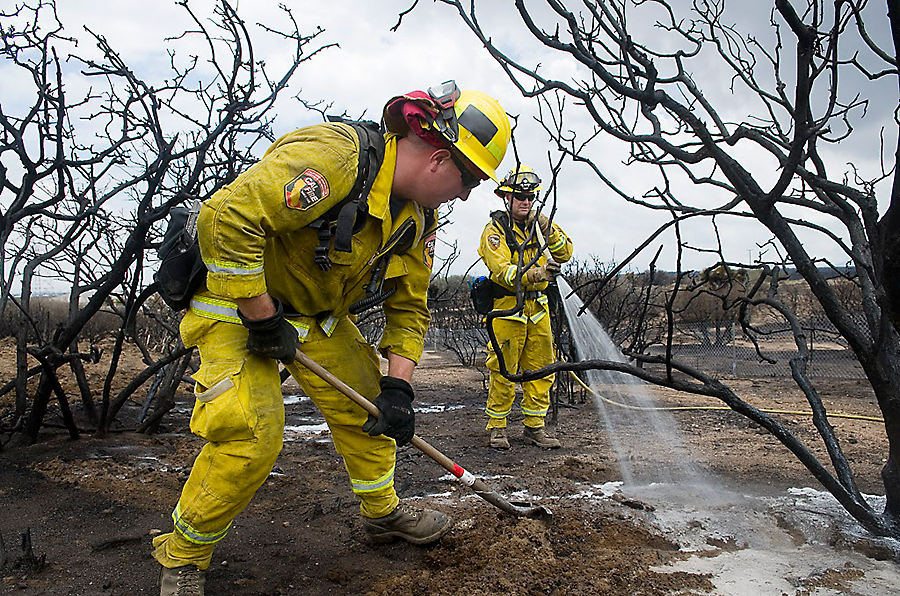Who pays for fighting wildfires? US lawmakers deadlocked on funding.
As the wildfire season rages in the western US, another seasonal flare-up is underway in Washington D.C.: Congress is deadlocked over how firefighting should be funded.
Some members of Congress say it should be paid for like other relief efforts for natural disasters, instead of the US Forest Service having to borrow from its own programs aimed at preventing fires. Others say the Forest Service and the Obama administration should rein in the agency's budget for forest management.
The only problem with this perennial impasse is this year's fire season already appears to be the worst ever, with tens of thousands of acres ablaze just in California, and 66 million trees dead there since 2010.
The conflict shows the different modes of thought in Washington to address the growing intensity of wildfires, as warmer temperatures, drier weather, and human interference damages and destroys forests in the West.
“California is a tinderbox…all the more reason for Congress to act sooner, rather than later,” wrote The Sacramento Bee’s editorial board Friday. “We can’t afford, however, to continue to actively do nothing. Year-round fire seasons are now the new normal, and the cost of battling them piecemeal is too great.”
The Forest Service annually allocates money for wildfires at the 10-year average cost. When firefighting exceeds this amount, the agency must borrow from its own budget — which includes programs to prevent fires such as clearing brush from trails and campgrounds, and controlled burns to remove dead trees — instead of drawing from federal emergency disaster funds.
“That was politically and economically tolerable when there were fewer such fires (especially in the West, where most such wildland conflagrations occur) and the budget for fire-fighting covered at least most of the cost,” wrote Brad Knickerbocker for The Christian Science Monitor in August 2015. ”But in recent years, as drought conditions continued to increase – exacerbated, many experts say, by climate change – and homebuilding and other development pushed into what’s called the ‘wildland-urban interface,’ the budgeting situation worsened.”
From 1991 to 1999, the Forest Service and Interior Department spent a yearly average of $1.4 billion for wildfire protection, according to a report by Headwaters Economics, a nonprofit researcher. From 2002 to 2012, that amount more than doubled to a yearly average of $3.5 billion. In 2015, fire management burned through 56 percent of its $5 billion budget, according to a statement from the Forest Agency in June. The agency projects the percentage will increase to 67 percent in 2025, Mr. Knickerbocker reported for the Monitor.
Last month, the Forest Service urged Congress to see things its way.
“We must fund wildfire suppression like other natural disasters in the country," said Agriculture Secretary Tom Vilsack, the parent agency of the Forest Service, in a statement. “Forcing the Forest Service to pay for massive wildfire disasters out of its pre-existing fixed budget instead of from an emergency fund like all other natural disasters means there is not enough money left to do the very work that would help restore these high mortality areas.”
Legislation was drafted that would accomplish this end. In 2015, after President Obama urged Congress to fund wildfires like other natural disasters, the pending Wildfire Disaster Funding Act was introduced. At the time, a national coalition of conservation, timber, tribal, recreation, and employer groups praised the bipartisan bill. It has collected dust ever since. Though 147 members of the House of Representatives have signed on as co-sponsors, according to The Sacramento Bee, the last action for it was in March 2015, when it was referred to the Subcommittee on Federal Lands.
Some Republicans have rebuffed the legislation's associated costs. Instead, they have encouraged the Forest Service and presidential administration to improve how they carry out forest management.
"The wildfire problem is not just a budget problem — it's also a management problem," Alaska Republican Sen. Lisa Murkowski, chairwoman of the Senate Energy and Natural Resources Committee, said in a statement. "We have a real and growing problem on our hands, and resolving it will require a comprehensive approach that addresses both wildfire funding and forest management."
Ms. Murkowski and other committee members have proposed a plan that would support more fire prevention. Under the proposal, firefighting would still be funded at the 10-year average cost. But in years with fewer fires, any money leftover would be directed towards fire prevention projects.
Sens. Mike Crapo (R) of Idaho and Ron Wyden (D) of Oregon have signed onto the proposal, even though they wrote in an op-ed published in the Idaho County Free Press that it's not an "end-all solution."
"But it is a step in the right direction toward bringing everyone to the table and renewing our years-long call for action on wildfire funding," they wrote.
The House Appropriations Committee also approved in June an additional $3.9 billion to combat and manage wildfires. That action has not yet been scheduled for a vote.






